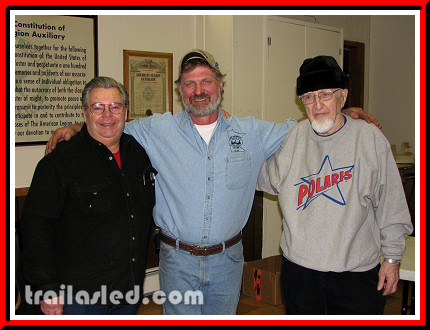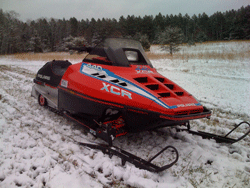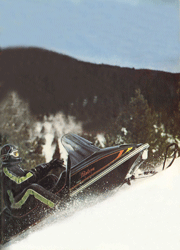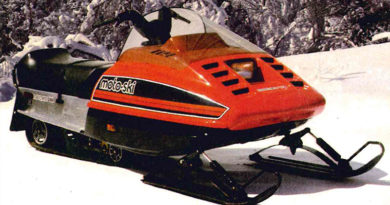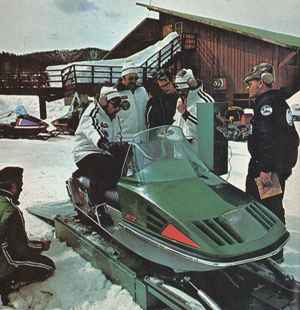FLASHBACK: 1972 Scorpion Stingers Fueled By Gutsy Ads
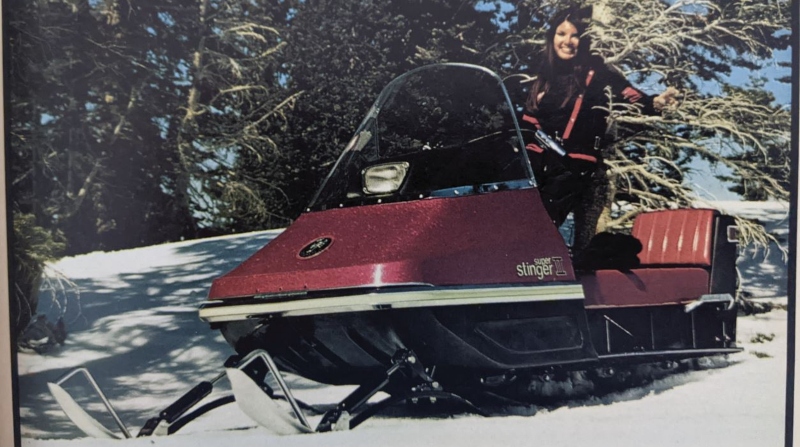
Winter mobility pioneer Scorpion, Inc. was a top 10 snowmobile manufacturer at the start of the 1970s. But it lagged far behind industry giant Bombardier and was also losing ground to fellow Minnesota-based rival Arctic Cat.
In 1971, a new Scorpion management team set an ambitious goal of becoming the number two manufacturer, with an internal battle cry of “Number 2 by ’72.” To get there, Scorpion needed a master stroke of marketing to drive sales of its new 1972 Stinger series.
Most of the ’72 Stingers were nearly all-new from the ground up. Attractive new styling included new consoles and seats. After a multi-year absence, JLO engines returned in some machines, with all models getting new and more efficient clutches. New padded buckhorn handlebars worked with new skis on a wider stance for better handling. A new hybrid suspension, the Para-Rail, was said to bridge the performance gap between bogies and sliders. And there were also new polyurethane tracks, new safety features and more.
But these sleds also retained some obsolete ideas, including engine placement on the tunnel (with the resulting high center-of-gravity), leg-breaker chassis stirrups, breaker point ignitions and an old-fashioned drum brake.
So, Scorpion dusted off an old idea from the automobile business. When Chrysler introduced their new Plymouth brand in the late 1920s, they cleverly positioned it against Ford and Chevrolet by calling this trio “the low-priced three.”
Scorpion adapted this concept to set up a “test the top three” ad campaign that pitted their new 1972 Stingers against two of the top sellers of the day. They actually began with 11 competitive 1971 models but cut to a final three machines: a Ski-Doo T’NT 440, an Arctic Cat Panther 440 and a Yamaha SS 440 with twin pipes.
In January of 1971, these three ’71 machines competed with a 1972 Super Stinger II JLO 440 prototype in eight comparison tests, including quarter-mile acceleration, a short oval race, hill climbing, braking, handling and stability. The new Scorpion was deemed the winner in every single event. A narrated 10-minute film of these tests was produced for potential buyers. You can see it today on YouTube as “1972 – Test Trials.” (It’s also at the bottom of this story.) And the Yamaha was dropped for the actual ad campaign.
Test The Top Three
“Only Scorpion Stinger dares to say: Test the top 3,” blared the ad headlines. “Let the seat of your pants tell you more than mere words can.”
These ads dared riders to pit a new Scorpion against a Cat or a ’Doo.
“Are we afraid you’ll buy one of the others?” they asked. “No. In head-to-head tests against the other two top machines, Stinger proved itself best in the business. In every test category, it was Stinger first in the functions you want.”
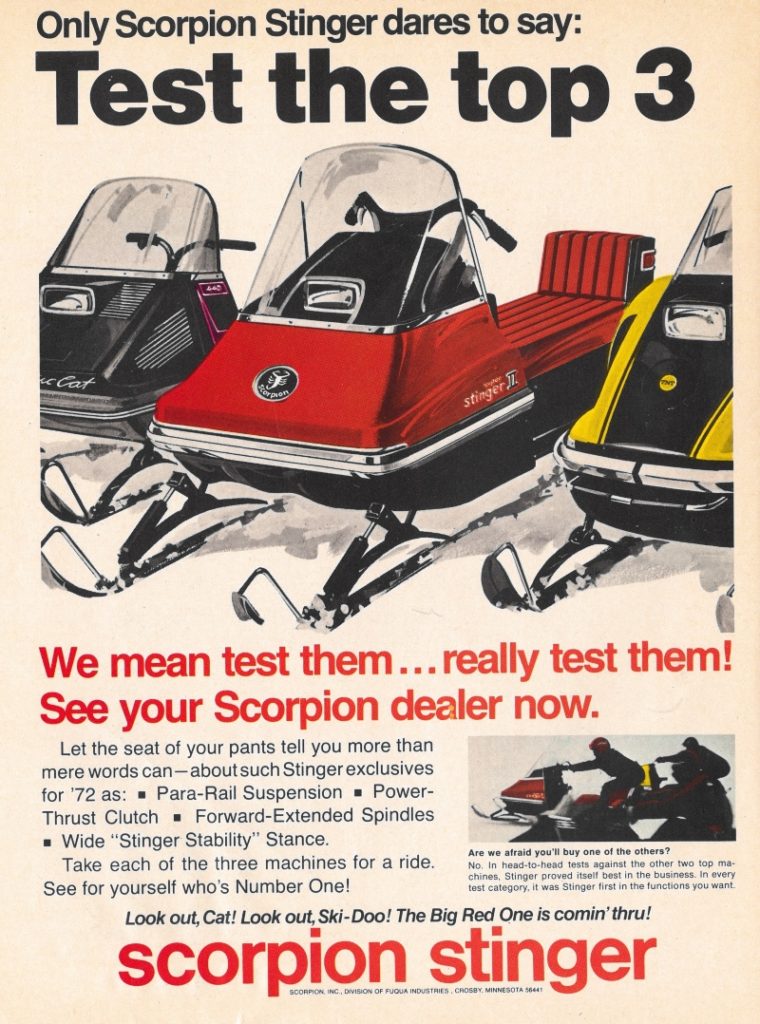
These ads usually included a smaller photo of a 1972 Super Stinger accelerating a half-length ahead of the 1971 Panther and 1971 T’NT that flanked the Scorpion. The photo supported Scorpion’s 1972 tagline “The Big Red One is comin’ through!”
The 1972 Scorpion brochure described these tests in further generalities, but no numbers or other significant details were ever published for consumers to read.
Sled magazines of the day ignored the Scorpion tests in their editorial coverage, sticking to their own spring tests of 1972 Scorpions. The publications were generally complimentary to the new Super Stinger II 440 that they tested despite the lack of a key feature, the new Para-Rail suspension.
“Believe us, the Scorpion is a comer,” stated Invitation To Snowmobiling. Meanwhile, Snow Goer said, “It will take a magnificent machine to keep them (Scorpion) out of third place in the industry this year.” Note that our predecessors said third, NOT second place.
The Results Are In
Snowmobilers voted with their hard-earned dollars, and the results were in by late spring. Scorpion built roughly 20,000 snowmobiles for 1972, about the same as for 1971, but retailed more sleds than that by reducing their prior year carryover.
However, the company’s market position really didn’t change at all. No reliable hard numbers are available but estimates by Snow Goer Trade magazine at the time had Scorpion still sitting in seventh place in overall sales. Ski-Doo was still number one by a wide margin while second place Arctic Cat was beginning to pull away from the rest of the pack. Bombardier’s Moto-Ski remained a solid third, but Scorpion still also significantly trailed Polaris, Sno*Jet and Rupp.
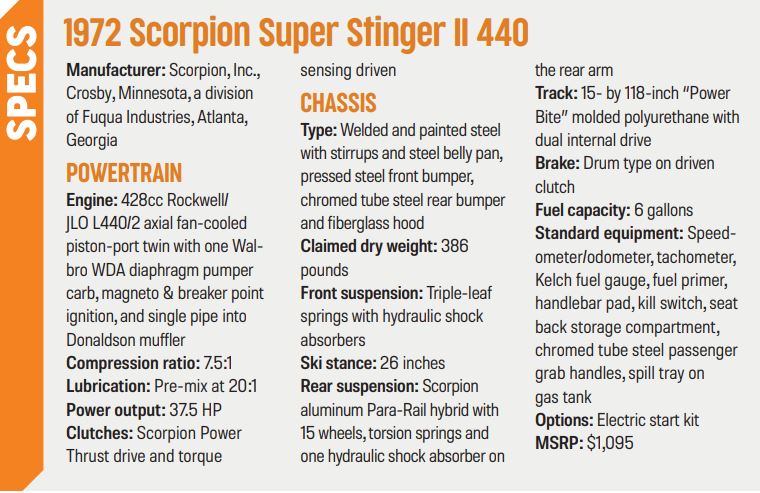
The Stinger guys were still sparring with Outboard Marine’s combined Evinrude and Johnson brands, plus Yamaha, Skiroule, Alouette, Boa-Ski and the numerous brands from Lionel Enterprises (Sno-Prince was the most important) for the honor of rounding out the top 10 manufacturers. Worse, Scorpion still had many leftover new ’72 sleds.
“Test the top three” was a gusty ad campaign, but it failed to improve Scorpion’s market position. Many of us at the time thought the tests were rigged, and careful inspection of the video by knowledgeable riders supports this view.
Scorpion was also fighting a continuing quality problem, and simply lacked the massive distributor and dealer networks of market leaders Bombardier and Arctic Cat. And in the end, “test the top three” just never resonated with consumers like Moto-Ski’s “Tougher Seven Ways” or Arctic’s annual marketing themes beginning with “This Is The Year of the Cat.”
So Scorpion stagnated until new ownership took over a couple of years later. After one more much stronger but still unsuccessful attempt to right the ship with the all-new Whip, Scorpion was finally sold to Arctic Cat. But that’s a tale for another time.
Editor’s Note: Every Snow Goer issue includes in-depth sled reports and comparisons, aftermarket gear and accessories reviews, riding destination articles, do-it-yourself repair information, snowmobile technology and more. Subscribe to Snow Goer now to receive print and/or digital issues.

